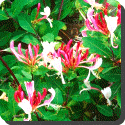 Honeysuckle — Honeysuckles Lonicera; syn. Caprifolium Mill.) are arching shrubs or twining vines in the family Caprifoliaceae, native to the Northern Hemisphere. There are about 180 species of honeysuckle, with by far the greatest diversity in China, where over 100 species occur; by comparison, Europe and North America have only about 20 native species each. Widely known species include Lonicera periclymenum (European Honeysuckle or Woodbine), Lonicera japonica (Japanese Honeysuckle, White Honeysuckle, or Chinese Honeysuckle) and Lonicera sempervirens (Coral Honeysuckle, Trumpet Honeysuckle, or Woodbine Honeysuckle). Hummingbirds are attracted to these plants.
Honeysuckle — Honeysuckles Lonicera; syn. Caprifolium Mill.) are arching shrubs or twining vines in the family Caprifoliaceae, native to the Northern Hemisphere. There are about 180 species of honeysuckle, with by far the greatest diversity in China, where over 100 species occur; by comparison, Europe and North America have only about 20 native species each. Widely known species include Lonicera periclymenum (European Honeysuckle or Woodbine), Lonicera japonica (Japanese Honeysuckle, White Honeysuckle, or Chinese Honeysuckle) and Lonicera sempervirens (Coral Honeysuckle, Trumpet Honeysuckle, or Woodbine Honeysuckle). Hummingbirds are attracted to these plants.
The leaves are opposite, simple oval, and from 1–10 cm long; most are deciduous but some are evergreen. Many of the species have sweetly-scented, bell-shaped flowers that produce a sweet, edible nectar. Breaking of the Honeysuckle’s stem will release this powerful sweet odor. The fruit is a red, blue or black berry containing several seeds; in most species the berries are mildly poisonous, but a few (notably Lonicera caerulea) have edible berries.
Wood cuttings from the species Lonicera tartarica, native to Eurasia, are sold as cat toys. The wood contains nepetalactone, which is the active ingredient found in catnip. Many breeds of cats react to the scent of the wood and will paw, lick or rub against it.
 Kids Portal For Parents India Kids Network
Kids Portal For Parents India Kids Network






